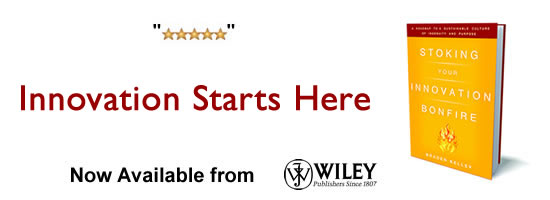3 Fatal Flaws Limiting Project-Based Innovation
 When people talk about innovation, many of the conversations gravitate towards the creation or invention of new products or markets. Fewer conversations focus on how innovation occurs in the context of professional services that deliver project or program outcomes for clients. In examining the typical life cycle of professional services projects, there appear to be at least three fatal flaws that limit innovation.
When people talk about innovation, many of the conversations gravitate towards the creation or invention of new products or markets. Fewer conversations focus on how innovation occurs in the context of professional services that deliver project or program outcomes for clients. In examining the typical life cycle of professional services projects, there appear to be at least three fatal flaws that limit innovation.
The fatal flaws suggest that innovation initiatives and expectations should be targeted at the program management level as opposed to the project management level.
To understand the difference, let’s first distinguish between project management and program management. The Independent Consulting Bootcamp does an excellent job of laying out the nuances of the distinction. In short,
·        A project is designed to deliver tangible outputs under predefined time, cost, and quality constraints within a tightly defined scope and generally shorter timelines. Projects typically move forward based on an approved business case that balances costs, benefits, and risks and have well-defined, measurable targets.   Project risks tend to be relatively definable and manageable, and there are a limited set of viable solutions to the problem that can be readily compared.
·        A program is a portfolio of projects managed and coordinated as one unit with the objective of achieving outcomes and benefits for the organization over an extended period. Targeted program outcomes may be intangible or more difficult to quantify and the scope of a program may be less tightly defined or more likely to change over time. Program risks tend to be broader and more complex, and there are often a broad suite of approaches or solutions that can be used to pursue objectives with less clarity around the preferred or optimal solution.
With this distinction in mind, let’s explore the three fatal flaws that limit innovation in many projects and why program level innovation may offer greater potential.
1)     Request for proposals for projects tend to be written with tightly defined scopes and outcomes and use evaluation criteria biased towards proven solutions based on past performance. It is important to note that this acquisition approach should be expected at a project level as acquisition professionals are trained to manage risk for the purchasing organization. It will take a fundamental retraining of acquisition professionals (potentially similar to the OMB digital acquisition professional training and development program) and realignment of their incentives to change how innovation is procured at a project level.
2)     Project managers are trained and rewarded for execution not innovation. The excellent book The Three Box Solution – A Strategy for Leading Innovation by Vijay Govindarajan argues that execution and innovation require different skillsets and mindsets. Project managers operate in Box 1 (Managing the Present) where they are appropriately focused on project cost, revenue, and deliverable performance. While they may introduce some incremental, linear innovations to marginally improve performance, they are not incentivized nor wired to identify and implement riskier, non-linear innovations (Box 3 – Creating the Future) that could lead to substantially better outcomes but also have a much higher risk of failure.  They are also not incentivized to selectively forget the past (Box 2) if past methods are likely to meet minimal project requirements. It is unreasonable to expect a project manager (client or vendor) to simultaneously focus on project execution while also innovating in ways that forget a successful past to create a new, potentially riskier future.
3)     Activity-based pricing discourages innovation. In professional services, many contracts are time and materials or fixed fee. On time and materials contracts, the purchasing organization will be incentivized to manage the vendor in a way that delivers the defined outcomes of the project at the lowest potential cost to increase return on investment. On fixed fee projects, vendors are incentivized to deliver the defined outcomes of the project at the lowest possible cost to bank the margin. With tightly defined, contractually obligated outcomes, neither type of contract financially incentivizes the parties to innovate by going above and beyond the proposed work plan to deliver potentially high impact, but riskier innovations that could yield transformational outcomes. Outcome-based contracting is likely required to properly incentivize the development and implementation of project innovations.
The combination of the three fatal flaws heavily biases project management towards execution over innovation. However, program management offers substantially greater potential for innovation based on the longer period of performance and pursuit of generally less well-defined and less quantifiable outcomes. As just one example, a major Midwest utility runs an energy efficiency program portfolio. While projects for delivering energy efficiency solutions to specific sectors have well defined budgets and savings targets, the overall energy efficiency program portfolio includes a substantial innovation fund that seeks to identify and test innovative solutions that can yield transformational outcomes. As organizations explore how to use program management to drive innovation, there are at least two key concepts to consider:
1)     If your program has outcomes that are to be pursued over a time period beyond 12 months, it borders on arrogance to not have an integrated, systematic innovation management approach. With the rapid change in technology and approaches to pursue outcomes, robust innovation management at the program portfolio level is required to optimize return on dollars invested.
2)     The project managers in your program portfolio should not also be tasked with innovation. Program portfolios should include key staff who are trained in innovation (not just execution) and are specifically tasked with identifying, vetting, integrating, and scaling innovations in pursuit of program outcomes. These staff should report to the program manager but should not be constrained by the same execution burdens as project managers.
We’ll continue the discussion of the constraints on project-based innovation and the opportunities for better addressing innovation at the program management level in future posts. Please use the comments section to share any of your own perspectives on the challenges or opportunities you’ve seen in these areas.
Wait! Before you go…
Choose how you want the latest innovation content delivered to you:
- Daily — RSS Feed — Email — Twitter — Facebook — Linkedin Today
- Weekly — Email Newsletter — Free Magazine — Linkedin Group
 Dr. Michael “Whit†Whitaker is Vice President of Emerging Solutions for ICF International. He is responsible for fostering a culture of innovation where creative thinking, experimentation, prototyping, rapid iteration, and deep understanding of markets, clients, and end-user needs are used to develop new solutions that drive growth and customer satisfaction in rapidly emerging markets. Follow Whit on Twitter or connect on LinkedIn
Dr. Michael “Whit†Whitaker is Vice President of Emerging Solutions for ICF International. He is responsible for fostering a culture of innovation where creative thinking, experimentation, prototyping, rapid iteration, and deep understanding of markets, clients, and end-user needs are used to develop new solutions that drive growth and customer satisfaction in rapidly emerging markets. Follow Whit on Twitter or connect on LinkedIn
NEVER MISS ANOTHER NEWSLETTER!
LATEST BLOGS
Learning Innovations from Microsoft
Want to read up on the latest technologies or innovative business thinking? If you’re committed to continuous learning to maintain…
Read MorePossible Strategic Innovation in Tobacco?
Do you truly know how your customers want to consume your product? Cigarettes are of course typically sold by the…
Read More



